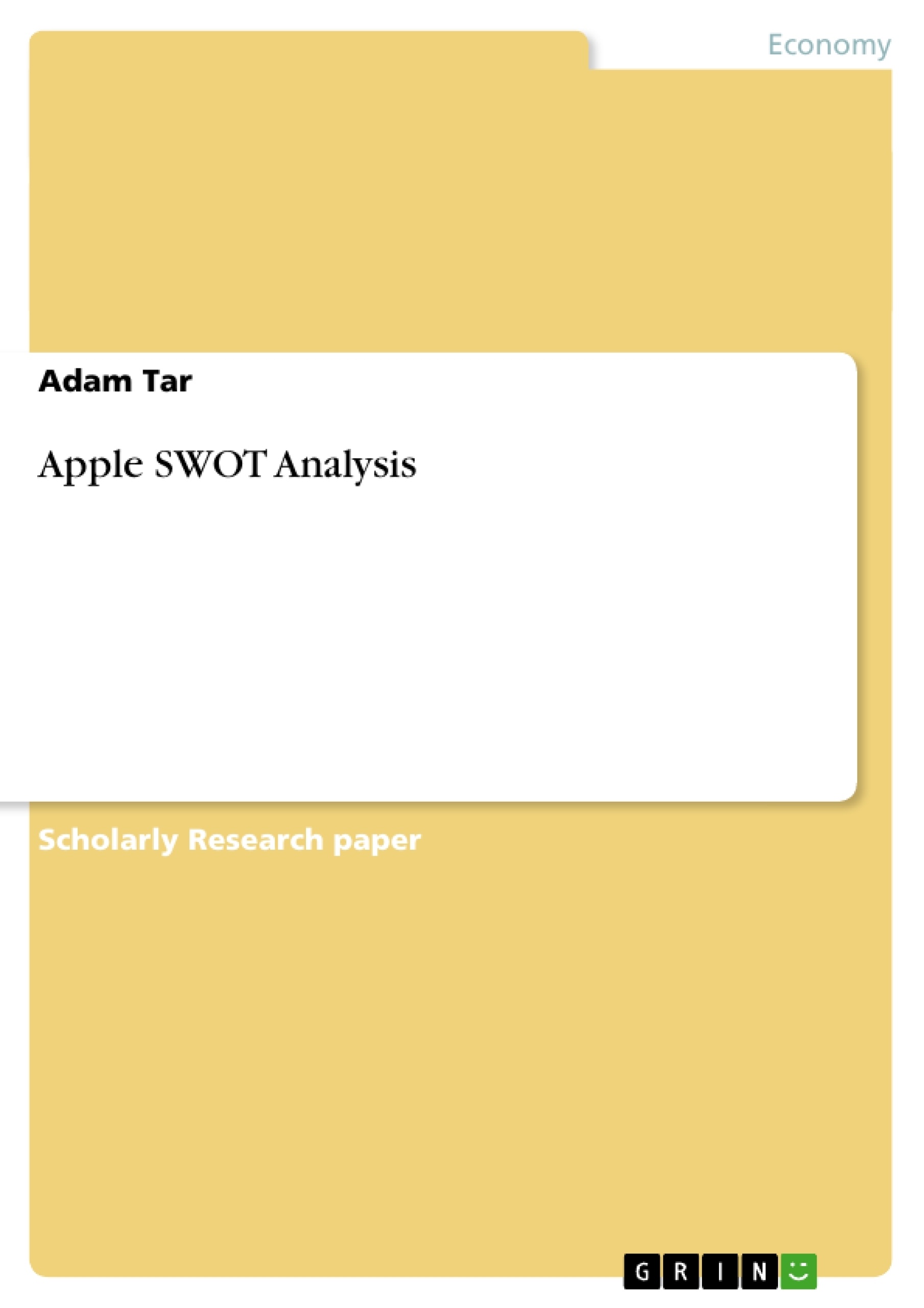Excerpt
Apple Inc. SWOT Analysis
When reflecting on technology, and the progress that we have made in the last ten years, it is hard to imagine where we would be today without it. We as a society have integrated technology into our lives every single day. A large part of this is due to the ability to connect to the world with our fingertips whenever and wherever we may be. Whether we are surfing the web, listening to music, face timing with our friends and or loved ones, or simply checking in on our social networks. Technology has become a norm and a hygiene factor of our society that most of us could not live without.
Apple Inc. and its former CEO, Steve Jobs deserve a substantial amount of credit for these changes. They have led the way in innovation, user friendliness, and ascetically pleasing products that many have tried to contend with and have had no success. Apple Inc. has created a brand so powerful, that their products themselves have become fashionable and almost a never-ending trend. Their brand loyalty is so deep that consumers will stand in lines for not hours but, days awaiting the release of the newest product, even if the changes that are made to it are minimal. They are the first and only company to create a line of products that seamlessly integrate together, and are accessible anywhere with a cellphone signal. However, many question the company’s viability due to the recent passing of former CEO Steve Jobs. Will Apple Inc. be able to continue in its predecessor’s footsteps? Or will Apple Inc. dwindle away like last years fashion trend? This paper will examine Apple Inc. using a SWOT Analysis, and will bring to light Apple Inc. areas of strengths, weaknesses, opportunities and threats.
Apple Inc. Background
In April of 1976, Steve Wozniak and Steve Jobs created Apples first product in Wozniak’s garage; it was called the Apple I. In order to obtain funding to produce the product and the company they sold a van and two calculators for about $ 1,300. This was enough capital to begin Apple Inc., and begin to produce their first product, the Apple I. Jobs and Wozniak, were able to sell 250 units of the Apple I for total sales revenue of $166,500. This money allowed them the opportunity to create the Apple II. Keeping the consumer in mind, they wanted to create a product that was more appealing to non-business oriented users. So they created the housing out of beige plastic rather than a traditional metal box. By 1977 a year after the release of the Apple II hitting retail stores they had reached an annual sales revenue of $1 million dollars.
A few problems, and several models later, Jobs and Wozniak introduced the Macintosh in 1984. Jobs believed that the Macintosh would be “the peoples computer” (“Reference for Business”, n.d.). His beliefs proved to be true, the success of the Macintosh was huge, within the first 100 days, 70,000 units had sold at $2,495 a unit. However, not all was well within Apple Inc.. In 1985 Jobs and several other executives decided to leave Apple Inc. and created NeXT. Yet this was not the end of Apple Inc. problems; from 1988 up until 1966 Apple Inc. had a slew of problems. Amongst those were over ordering inventory, failing to fill orders on time, poor leadership, and investors that were loosing interest due to recent failures. Not only did it put Apple Inc. into the red but it was also almost enough to put them out of business. This began to change in December of 1996 when they acquired a company called NeXT, that had a hidden gem CEO, Steve Jobs.
Jobs entered back into Apple Inc. with the same drive and motivation that he prior to leaving. He immediately began to reorganize the company and eliminate all of the waste. As part of this, he “eliminated 15 of the 19 products withdrawing Apple’s involvement in making printers, scanners, portable digital assistants, and other peripherals” (“Reference for Business”, n.d.). Jobs began shutting down plants, started laying off employees, and sold stock to their number one rival Microsoft Inc. Jobs strategic plan was to simply focus on selling desktop and laptop computers to professionals and regular consumers. As a result of this new vision, the IMAC was produced. This was the success that Apple Inc. was searching for. Jobs brought Apple Inc. back into the green “a 94 percent gain in net income” (“Reference for Business”, n.d.) to be exact, brining Apple Inc.’s overall profit to $601 million dollars. However, Job’s success does not stop there. In 2001, he introduces the IPOD, a huge success, and unlike anything seen by consumers during its time. In 2005 Jobs brought out the video IPOD, again another huge success. Over the next six years Jobs introduced dozens of products that changed the way consumers looked at electronics e.g. the IPAD, the IPHONE, a number of powerful computers, and a flawless operating system for all of their devices that can be linked, and utilized from anywhere around the world. He created a complete package where every device works together, something that has not been seen with any other products in the industry. Unfortunately, in 2011 Steve Jobs died from Pancreatic Cancer. However, Jobs created a legacy and a billion-dollar company through his strong leadership skills, creativity, and willingness to succeed that no one will forget.
[...]
- Quote paper
- MBA Candiate Adam Tar (Author), 2013, Apple SWOT Analysis, Munich, GRIN Verlag, https://www.grin.com/document/215816
Publish now - it's free






















Comments